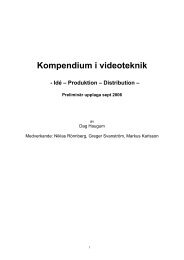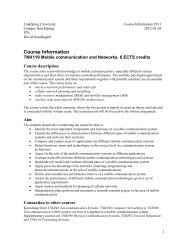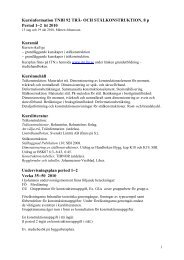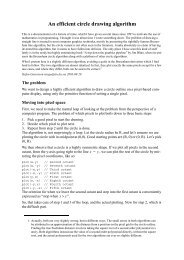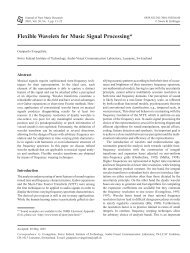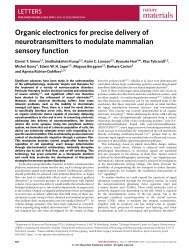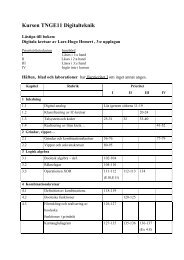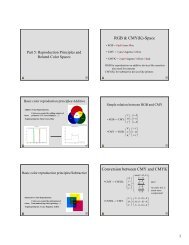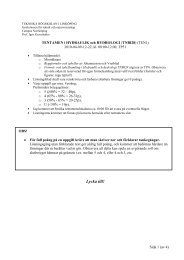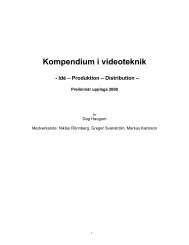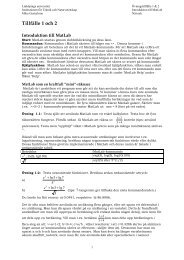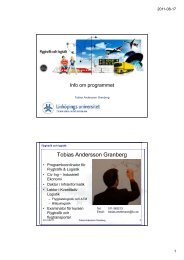TNFL03 – Case study descriptions
TNFL03 – Case study descriptions
TNFL03 – Case study descriptions
You also want an ePaper? Increase the reach of your titles
YUMPU automatically turns print PDFs into web optimized ePapers that Google loves.
Tobias Andersson Granberg<br />
Shelley Torgnyson<br />
<strong>TNFL03</strong> <strong>–</strong> <strong>Case</strong> Studies in Air Traffic<br />
Management and Logistics<br />
<strong>TNFL03</strong> <strong>–</strong> <strong>Case</strong> <strong>study</strong> <strong>descriptions</strong><br />
<strong>Case</strong> studies<br />
The main purpose of the case studies is to give the students the opportunity to strengthen<br />
their expertise in air traffic and logistics, while training and developing the English language.<br />
Thus, for each case <strong>study</strong>, the students are expected to make a detailed <strong>study</strong> within one<br />
specific area.<br />
<strong>Case</strong>s<br />
The four cases that will be handled in the course are:<br />
1. Aviation security<br />
2. Environmental effects of flying<br />
3. Infrastructure development of airports<br />
4. Aviation crisis management<br />
Each case can be divided into a number of topics (examples of topics can be found in the<br />
specific case <strong>descriptions</strong>), and one topic should be selected for further <strong>study</strong>. Do not try to<br />
carefully review everything that can fit under a specific case; there is not enough time. Make<br />
a quick review of available topics, pick one specific topic and try to reach beyond the<br />
descriptive state, into an analytic state. Formulate a purpose with your <strong>study</strong> and one or<br />
more specific <strong>study</strong> questions that you will answer.<br />
Example 1<br />
<strong>Case</strong>: 1<br />
Topic: Process improvements<br />
Purpose: To analyze the benefits and the disadvantages of a new scanner technology at a<br />
specific airport<br />
Study question: With the new scanner technology, what would be the increase in security<br />
(and how is this measured)?<br />
Study question: How will the passenger flow through security be affected?<br />
Example 2<br />
<strong>Case</strong> 4:<br />
Topic: Aspects of communication and information flow<br />
Purpose: To investigate the potential benefits of an airport CDM system<br />
Study question: Do airports with a functioning CDM system handle crises more efficiently<br />
than airports without a CDM system?<br />
Suggested work plan<br />
1. Individual information gathering and knowledge buildup<br />
2. Present what you have learnt for each other, within the group<br />
3. Select a topic, formulate a purpose and <strong>study</strong> questions<br />
4. Dig deeper<br />
5. Analyze your findings, write a report<br />
6. Prepare a presentation
Tobias Andersson Granberg<br />
Shelley Torgnyson<br />
<strong>TNFL03</strong> <strong>–</strong> <strong>Case</strong> Studies in Air Traffic<br />
Management and Logistics<br />
Report<br />
The final report should contain an “Introduction”, containing “Background”, “Purpose”,<br />
“Study Questions” and “Methodology”. Furthermore, the report must include an “Analysis”<br />
part and “Conclusions”. Of course, relevant “References” should be included and must<br />
number at least three distinctly different sources. (More information on writing reports will<br />
be discussed in class with Shelley)<br />
Presentation and review<br />
An oral presentation of the case <strong>study</strong> will be made at the end of the period. Each group will<br />
also be assigned as peer reviewers to another group and is expected to carefully read,<br />
review and comment on the other report.<br />
Examination and grade<br />
The case reports, presentations and reviews will be examined and graded in terms of the<br />
English (by Shelley) and in terms of the content (by Tobias). The content will only be graded<br />
as Pass or Fail.<br />
Practicalities<br />
Each case will be performed in groups of max 5 students. A student will participate in two<br />
case studies, one <strong>study</strong> the first period (<strong>Case</strong> 1 or 2), and one the second period (<strong>Case</strong> 3 or<br />
4). In each class, there should be an equal amount of groups <strong>study</strong>ing <strong>Case</strong> 1 as there is<br />
<strong>study</strong>ing <strong>Case</strong> 2 (and 3 vs. 4 in period 2). A group <strong>study</strong>ing <strong>Case</strong> 1 will be assigned as peer<br />
reviewers to a group <strong>study</strong>ing <strong>Case</strong> 2.
Tobias Andersson Granberg<br />
Shelley Torgnyson<br />
<strong>TNFL03</strong> <strong>–</strong> <strong>Case</strong> Studies in Air Traffic<br />
Management and Logistics<br />
<strong>Case</strong> one <strong>–</strong> Aviation security<br />
A recent survey conducted by the U.S. Travel Association has revealed that 75% of air<br />
travellers believe that it must be possible to devise better alternatives to the current airport<br />
security screening process. It also showed that the average traveller would take two or three<br />
more trips a year if the security process could be made more convenient without<br />
compromising security. As a response, the U.S. travel association has formed an expert panel<br />
to come up with a suggestion for a process that maximizes security and minimizes the<br />
burden on air travelers.<br />
Your task is to make a short <strong>study</strong> on a specific area within aviation security. You are fairly<br />
free to pick a topic that you find suitable and interesting. Suggestions are offered below:<br />
Process improvements<br />
Technology<br />
Human resources management<br />
Capital investments<br />
Privacy protections<br />
<strong>Case</strong> two ‐ Environmental effects of flying<br />
According to a number of experts, the current growth of the aviation sector will result in an<br />
increase in CO2 emissions caused by commercial air traffic. To counteract expected<br />
increases in emissions, many governments and international organizations have set goals for<br />
future emissions reductions. To be able to meet the challenge of reducing emissions while<br />
maintaining its current business growth, the aviation industry needs to investigate what<br />
solutions are available today and in the near future.<br />
Your task is to look at one of the areas below in order to find out what existing and potential<br />
future improvements can be made to reduce commercial aircraft emissions and noise:<br />
Technological options (engine design, aircraft design, material, etc)<br />
Operational options (air traffic management, maintenance, etc)<br />
Policy changes (taxes, subsidies, research investments, Single European Sky, etc)<br />
Alternative fuel options (bio‐fuel, hydrogen etc)
Tobias Andersson Granberg<br />
Shelley Torgnyson<br />
<strong>TNFL03</strong> <strong>–</strong> <strong>Case</strong> Studies in Air Traffic<br />
Management and Logistics<br />
<strong>Case</strong> three <strong>–</strong> Infrastructure development of airports<br />
Air transport has seen tremendous growth over the last 50 years, which has led to an<br />
increased need for airport capacity. In order to successfully expand and develop an airport it<br />
is necessary to take into account the various aspects of airport infrastructure. As a first step<br />
it is essential to identify where the need for a capacity increase lies, and to ensure that the<br />
new infrastructure will be utilized when finished.<br />
Your task is to make a short <strong>study</strong> of one or more airports that have been involved in<br />
developing and expanding its capacity, in order to investigate the infrastructural strategies<br />
and problems of the development process. It is also possible to generalize the <strong>study</strong> by<br />
focusing on a specific area. You are free to look at any aspects of airport infrastructure, but<br />
some suggestions are given below:<br />
Landside access (i.e. train, bus, car)<br />
Geographical limitations<br />
Terminal design<br />
Air cargo<br />
Aircraft types, e.g. new large aircraft (NLA)<br />
<strong>Case</strong> four <strong>–</strong> Aviation crisis management<br />
In recent times, there have been many events which have hit the commercial aviation sector<br />
hard. One of the most disruptive and costly ones was the Volcanic ash cloud in 2010 which<br />
continues to constitute a threat to European Airspace. Its devastating effect on Europe’s<br />
airports and airlines was exceptional and put emergency planning experts to the test around<br />
the world. In addition to the ash cloud, there have been such incidents as airport closures in<br />
both the UK and US due to unusually heavy weather, political unrest in different parts of the<br />
world, pandemic outbreaks and a number of other global occurrences which have had a<br />
fundamental impact on the aviation sector.<br />
Your task is to make a short <strong>study</strong> on a specific area within aviation crises management. You<br />
are fairly free to pick a topic that you find suitable and interesting, however, do not choose<br />
the Volcanic ash case mentioned above. Suggestions are offered below:<br />
<br />
<br />
<br />
<br />
<br />
<br />
<br />
Models and methods for crises management<br />
Specific incidents and lessons learnt from them in terms of organisation and response<br />
Crises management in relation to different parties involved in the situation, i.e.<br />
controllers, flight crew, passengers, relatives, the public, etc.<br />
Aspects of communication and information flow in crisis situations<br />
Different types of crises and their specific problems, e.g. terror actions, accidents,<br />
epidemics, weather problems, natural disasters, political unrest, etc.<br />
Disaster recovery<br />
Contingency planning



